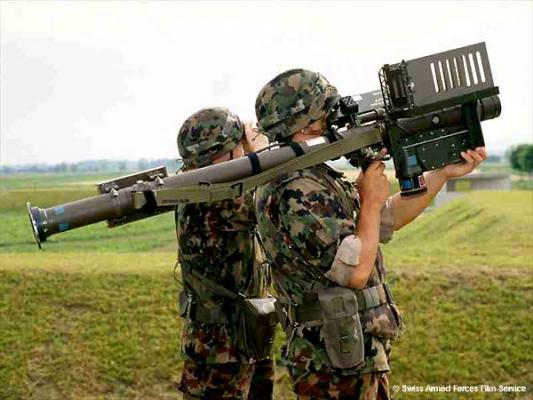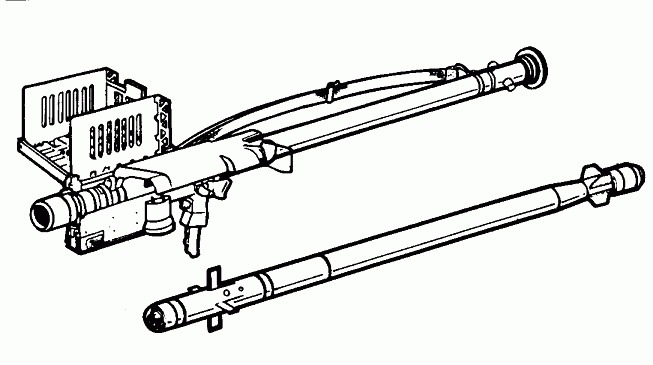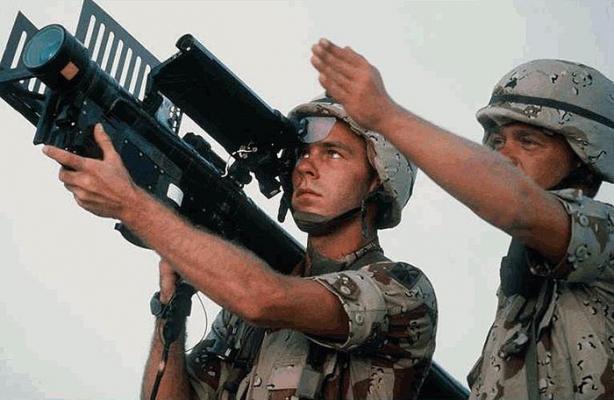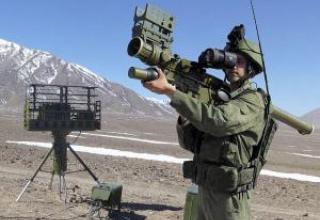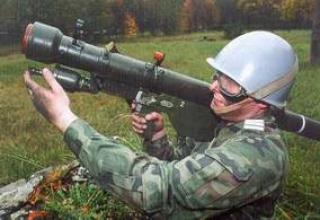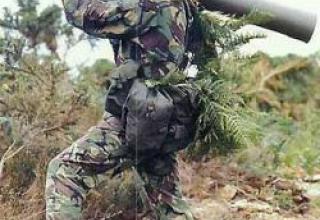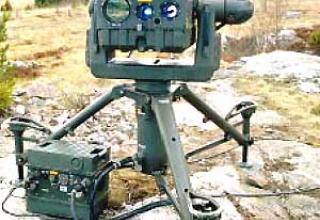Portable anti-aircraft missile system (MANPADS) "Stinger" is designed to defeat both on counter and overtaking courses of aircraft, including supersonic, and helicopters flying at low and extremely low altitudes. This complex, created by General Dynamics, is the most massive means of combating air targets in the service of foreign armies.
Man-portable air defence systems "Stinger" are in the service of a number of countries, including Western European partners in NATO (Greece, Denmark, Italy, Turkey, Germany), as well as Israel, South Korea and Japan.
Three modifications were developed: Stinger (basic), Stinger-POST (Passive Optical Seeking Technology) and Stinger-RMP (Reprogrammable Microprocessor). They have the same composition, as well as range and target altitude values, differing only by the homing heads (Homing Heads) used on FIM-92 antiaircraft missiles of modifications A, B and C, corresponding to the above three modifications of man-portable air defence systems. Raytheon is currently manufacturing modifications of the FIM-92D, FIM-92E Block I and FIM-92E Block II.
The development of the Stinger complex was preceded by work on the ASDP (Advanced Seeker Development Program), which began in the mid-60's, shortly before the launch of serial production of man-portable air defence systems "Red Eye" and aimed at theoretical study and experimental confirmation of the feasibility of the concept of the complex "Red Eye-2" with a rocket, which was to find use of all-around infrared CNS. The successful implementation of the ASDP program enabled the U.S. Department of Defense to begin funding the development of a promising man-portable air defence system in 1972 called the "Stinger". This development was completed by 1977, despite the difficulties encountered during its implementation, and General Dynamics began production of the first batch of samples tested between 1979 and 1980.
Composition:
Test results of the Stinger man-portable air defense system with a FIM-92A missile equipped with infrared GSN (wavelength range 4.1-4.4 µm), which confirmed its ability to engage targets on counter courses, allowed the Ministry of Defense to decide on serial production and delivery of the complex to the U.S. Army in Europe since 1981. However, the quantity of man-portable air defence systems for this modification in the original production programme was significantly reduced due to the progress made in developing the POST COS, which began in 1977 and was at that time in its final stages.
The dual-band POST COS used on the FIM-92B RMS operates in IR and ultraviolet (UV) wavelengths. Unlike the IR CNS of the FIM-92A, where information on the target position relative to its optical axis is extracted from a signal modulated by a rotating radar, it uses a rasterless target coordinator. Its detectors of IR and UV radiation, working in the same circuit with two digital microprocessors, allow for rosette scanning, which provides, firstly, a high possibility of target selection in the conditions of background interference, and secondly, protection from countermeasures IR range.
Production of the FIM-92B SSD with POST began in 1983, but due to the fact that in 1985 General Dynamics began to create the FIM-92C SSD, the production rate was reduced compared to the previously planned one. The new missile, which was completed in 1987, uses POST-RMP COS with a reprogrammable microprocessor to adapt the guidance system characteristics to the target and interference environment by selecting appropriate programmes. Replaceable memory blocks storing typical programs are installed in the case of the Stinger-RMP man-portable air defence system launch mechanism. The latest developments of the Stinger-RMP were carried out with regard to equipping the FIM-92C missile with a ring laser gyroscope, a lithium battery and an improved roll angle sensor.
Man-portable air defence systems "Stinger" of all modifications consists of the following main elements:
- ZUR in the transport and launch container (TPC),
- telescopic sight for visual detection and tracking, as well as for approximate determination of the target's distance to it,
- the trigger,
- power supply and cooling unit with an electric battery and a capacity with liquid argon,
- Identification equipment AN/PPX-1 (electronic unit is carried on the belt of the anti-aircraft gunner).
The FIM-92E Block II missile is equipped with an all-angle thermal imaging CNS with an IR detector matrix located in the focal plane of the optical system.
The missile is designed according to the aerodynamic scheme "duck". There are four aerodynamic surfaces in the forward section, two of which are rudders, while the other two remain stationary relative to the ZUR hull. To control with a single pair of aerodynamic rudders, the missile rotates around its longitudinal axis, and the control signals coming from the rudders are consistent with its movement relative to that axis. The initial rotation of the rocket is achieved by tilting the launch accelerator nozzles relative to the hull. To maintain the rotation of the SAM in flight, the plane of the tail stabilizer, which, like the rudders, opens when the missile leaves the TLC, is installed at some angle to the hull. Control by means of one pair of rudders allowed to achieve significant reduction of weight and cost of flight control equipment.
The solid-propellant dual-mode marching engine Atlantic Research Mk27 ensures that the missile can accelerate to a speed of M=2.2 and maintain a relatively high speed throughout its flight to the target. This engine is activated after separation of the launch accelerator and removal of the rocket at a safe distance for the shooter-operator (about 8m.).
SAM equipment weighing about 3 kg consists of a shrapnel-type warhead, an impact fuse and a safety executable mechanism that ensures the removal of the safety steps of the fuse and issuing a command to self-destruct the missile in case of miss.
The SAM is located in an airtight GRP cylinder filled with inert gas. Both ends of the container are sealed with launch destructible lids. The front one is made of a material that passes IR and UV radiation, which allows the SSD to capture the target without disturbing the seal. Hermeticity of the container and high enough reliability of the ZUR equipment provide storage of missiles in armies without maintenance within ten years.
The launch mechanism, which is used to prepare the missile for launch and make the launch, is connected to the TIC with special locks. The electric battery of the power supply and cooling unit (this unit is installed in the case of the launch mechanism in preparation for firing) is connected to the onboard network of the rocket through a plug slot, and the liquid argon container is connected to the cooling system via a plug. On the lower surface of the launch mechanism is a plug slot for connecting the electronic block of identification equipment "svoiuzhoy", and on the handle - a trigger with one neutral and two working positions. When the trigger is pressed and transferred to the first working position, the power supply and cooling unit is activated, resulting in electric power from the battery (20 volt voltage, operating time not less than 45 sec.) and liquid argon coming on board the rocket, providing cooling of CNS detectors, gyroscope unwinding and other operations associated with the preparation of the SAM for launch. At the further pressure on a trigger and occupation by it of the second working position the onboard electric battery capable to feed the electronic equipment of a rocket within 19 seconds is activated, and the ignition of starting engine of LSD is triggered.
In the course of combat operations, target data are received from an external detection and designation system or from the calculation number that monitors the airspace. After target detection, the shooter operator places the man-portable air defence system on his shoulder and points it at the selected target. When the missile's GSN captures it and begins to escort it, an acoustic signal and a vibrating telescope sighting device, to which the shooter presses his cheek, warn of a target being captured. The gyro will then be unraveled by pressing a button. Before starting, the operator enters the necessary pre-emptive angles. He presses the trigger guard with his forefinger and the on-board battery starts to work. Its normal operation is triggered by a cartridge with compressed gas, which rejects the breakaway plug, disconnecting power from the power supply and cooling unit and starting the starter engine pyrophatron. Translated with www.DeepL.com/Translator (free version)
The Stinger rocket is used as a means of destruction in a number of short-range anti-aircraft systems ("Avenger", "Aspic", etc.). A lightweight Stinger Dual Mount launcher has also been developed (see photos 1, 2, 3, 4, 5, 6), which consists of two standard systems located horizontally.
Characteristics:
| Defeat zone, m: - by distance (inhaling) - in height |
500 - 4750 (up to 8 km for FIM-92E) 3500 |
| Weight of the complex in combat position, kg | 15.7 |
| Missile launch weight, kg | 10.1 |
| The length of the rocket, mm | 1500 |
| The diameter of the rocket body, mm | 70 |
| The scale of the stabilizers, mm | 91 |
| Weight BC, kg | 2.3 |
| Rocket speed, m/sec. | 640 |
Testing:
The main combat unit of man-portable air defence systems "Stinger" is the calculation of the commander and the shooter-operator, which has six SAMs in the PIC, an electronic block of warning and display of air situation, as well as a vehicle with cross-country ability M998 "Hammer" (wheel arrangement 4x4). The main calculations are available in the regular air defense divisions of the U.S. divisions (in the air assault division there are 72 of them, in the armored division - 75, in the light infantry division - 90), as well as in the divisions of SAM "Patriot" and "Improved Hawk".
Man-portable air defence systems "Stinger" were widely used in local conflicts in recent decades. It was also used by the mujahedin during the war in Afghanistan against the Soviet troops. During the first two weeks of its use in early 1987, the Stinger man-portable air defence system shot down three Su-25s and killed two pilots. By the end of 1987, the losses amounted to almost an entire squadron of eight aircraft. Thermal traps did not save the vehicle from an already launched rocket, and the powerful BC was very effective at hitting the Su-25 engines, causing a fire that burned out the stabiliser control cables.
Sources:
- А.Толин "Aмериканский ПЗРК "Стингер", Заpубежное Военное Обозpение, N1,1991г.
- http://www.fas.com
- Виктор Марковский. Жаркое небо Афганистана
- http://kr.blog.yahoo.com
